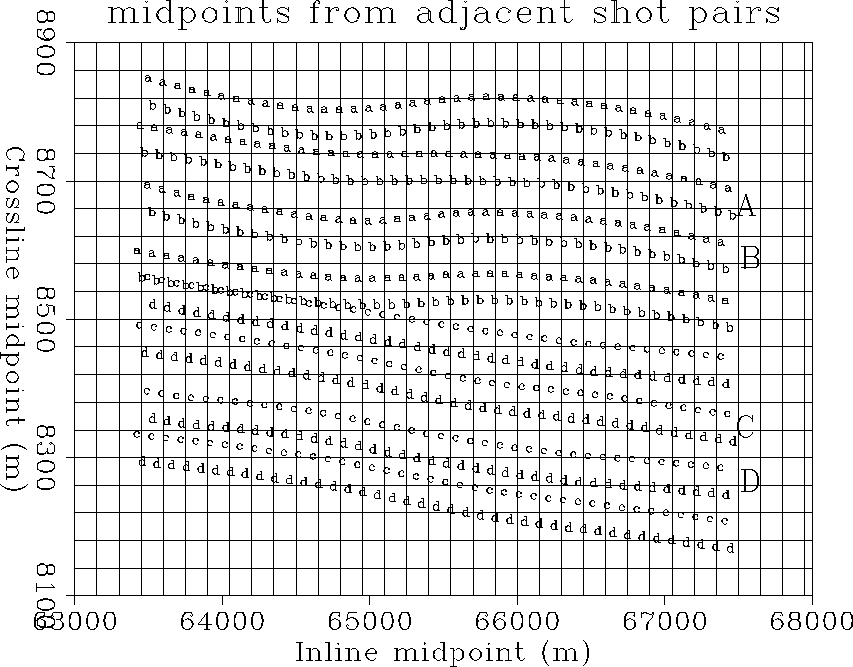




Next: LSJIMP and wide tow
Up: Least-squares joint imaging of
Previous: Nonlinear Iteration Test
3-D Theory
In marine environments, three-dimensional reflection seismic data is normally
acquired in a so-called ``wide tow'' streamer configuration, illustrated in
Figure ![[*]](http://sepwww.stanford.edu/latex2html/cross_ref_motif.gif) . Ironically, the crossline offset range of this
data is less than with most land acquisition geometries, so geophysicists often
call towed streamer data ``narrow azimuth'' data. Note that the crossline shot
interval,
. Ironically, the crossline offset range of this
data is less than with most land acquisition geometries, so geophysicists often
call towed streamer data ``narrow azimuth'' data. Note that the crossline shot
interval,  , is chosen such that the outermost receiver line on one
swath overlaps the innermost receiver line on the previous swath. Figure
, is chosen such that the outermost receiver line on one
swath overlaps the innermost receiver line on the previous swath. Figure
![[*]](http://sepwww.stanford.edu/latex2html/cross_ref_motif.gif) illustrates that such an acquisition geometry produces a
regularly sampled crossline CMP axis, if cable feathering is absent. In one
sense, this geometry boasts some degree of optimality, as it produces a
well-sampled 3-D image at a minimum cost.
illustrates that such an acquisition geometry produces a
regularly sampled crossline CMP axis, if cable feathering is absent. In one
sense, this geometry boasts some degree of optimality, as it produces a
well-sampled 3-D image at a minimum cost.
narrow-az
Figure 1 Wide tow marine geometry. The acquisition boat
tows many (usually 4-12) receiver lines and steams in parallel sail lines.

cgg-midpoints
Figure 2
Midpoint locations from two adjacent sail lines of the CGG Green Canyon 3-D
dataset. The boat tows four streamers and fires two sources alternatively in
a ``flip-flop'' configuration. Midpoints from shot ``A'' are labeled ``a'',
and so on. Two shot pairs from each sail line are shown. For a fixed ship
speed, this geometry doubles crossline midpoint density, at the cost of
reduced inline resolution, compared to a single-source configuration.
Flip-flop shooting allows one airgun to be recharged while the other shoots,
thereby allowing the ship to sail faster than would be possible with one gun.
Cable feathering is evident, though not severe.





Unfortunately, geometry shown in Figure ![[*]](http://sepwww.stanford.edu/latex2html/cross_ref_motif.gif) causes the 3-D
extension of the SRME method of multiple prediction to fail spectacularly. SRME
requires
causes the 3-D
extension of the SRME method of multiple prediction to fail spectacularly. SRME
requires  to be relatively small-in practice, roughly the same as
commonly chosen crossline receiver line spacing parameters van Borstelen (2003).
3-D field datasets commonly have a crossline shot interval of up to ten times
the crossline receiver line spacing. Workarounds for the 3-D sampling problem
include: ignoring crossline structure and using a 2-D prediction, massive
(270,000 CPU hours) shot interpolation Kleemeyer et al. (2003), sparse inversion of the
crossline multiple contribution gathers Hokstad and Sollie (2003); van Dedem and Verschuur (2002),
and novel acquisition geometries Paffenholz (2003). Currently, none of these
methods combines proven accuracy with computational/cost efficiency.
to be relatively small-in practice, roughly the same as
commonly chosen crossline receiver line spacing parameters van Borstelen (2003).
3-D field datasets commonly have a crossline shot interval of up to ten times
the crossline receiver line spacing. Workarounds for the 3-D sampling problem
include: ignoring crossline structure and using a 2-D prediction, massive
(270,000 CPU hours) shot interpolation Kleemeyer et al. (2003), sparse inversion of the
crossline multiple contribution gathers Hokstad and Sollie (2003); van Dedem and Verschuur (2002),
and novel acquisition geometries Paffenholz (2003). Currently, none of these
methods combines proven accuracy with computational/cost efficiency.
The LSJIMP method has good potential to separate 3-D peglegs from wide tow
marine data. In Section ![[*]](http://sepwww.stanford.edu/latex2html/cross_ref_motif.gif) , I demonstrated how, in a fairly
complex 2-D setting, the HEMNO equation can model some complex multiples as
accurately as SRME. In this chapter, I outline a practical extension of my
implementation of LSJIMP to work on 3-D wide tow marine data.
, I demonstrated how, in a fairly
complex 2-D setting, the HEMNO equation can model some complex multiples as
accurately as SRME. In this chapter, I outline a practical extension of my
implementation of LSJIMP to work on 3-D wide tow marine data.





Next: LSJIMP and wide tow
Up: Least-squares joint imaging of
Previous: Nonlinear Iteration Test
Stanford Exploration Project
5/30/2004
![[*]](http://sepwww.stanford.edu/latex2html/cross_ref_motif.gif) . Ironically, the crossline offset range of this
data is less than with most land acquisition geometries, so geophysicists often
call towed streamer data ``narrow azimuth'' data. Note that the crossline shot
interval,
. Ironically, the crossline offset range of this
data is less than with most land acquisition geometries, so geophysicists often
call towed streamer data ``narrow azimuth'' data. Note that the crossline shot
interval, ![[*]](http://sepwww.stanford.edu/latex2html/cross_ref_motif.gif) illustrates that such an acquisition geometry produces a
regularly sampled crossline CMP axis, if cable feathering is absent. In one
sense, this geometry boasts some degree of optimality, as it produces a
well-sampled 3-D image at a minimum cost.
illustrates that such an acquisition geometry produces a
regularly sampled crossline CMP axis, if cable feathering is absent. In one
sense, this geometry boasts some degree of optimality, as it produces a
well-sampled 3-D image at a minimum cost.

